check engine TOYOTA GR86 2022 (in English) User Guide
[x] Cancel search | Manufacturer: TOYOTA, Model Year: 2022, Model line: GR86, Model: TOYOTA GR86 2022Pages: 582, PDF Size: 86.38 MB
Page 108 of 582
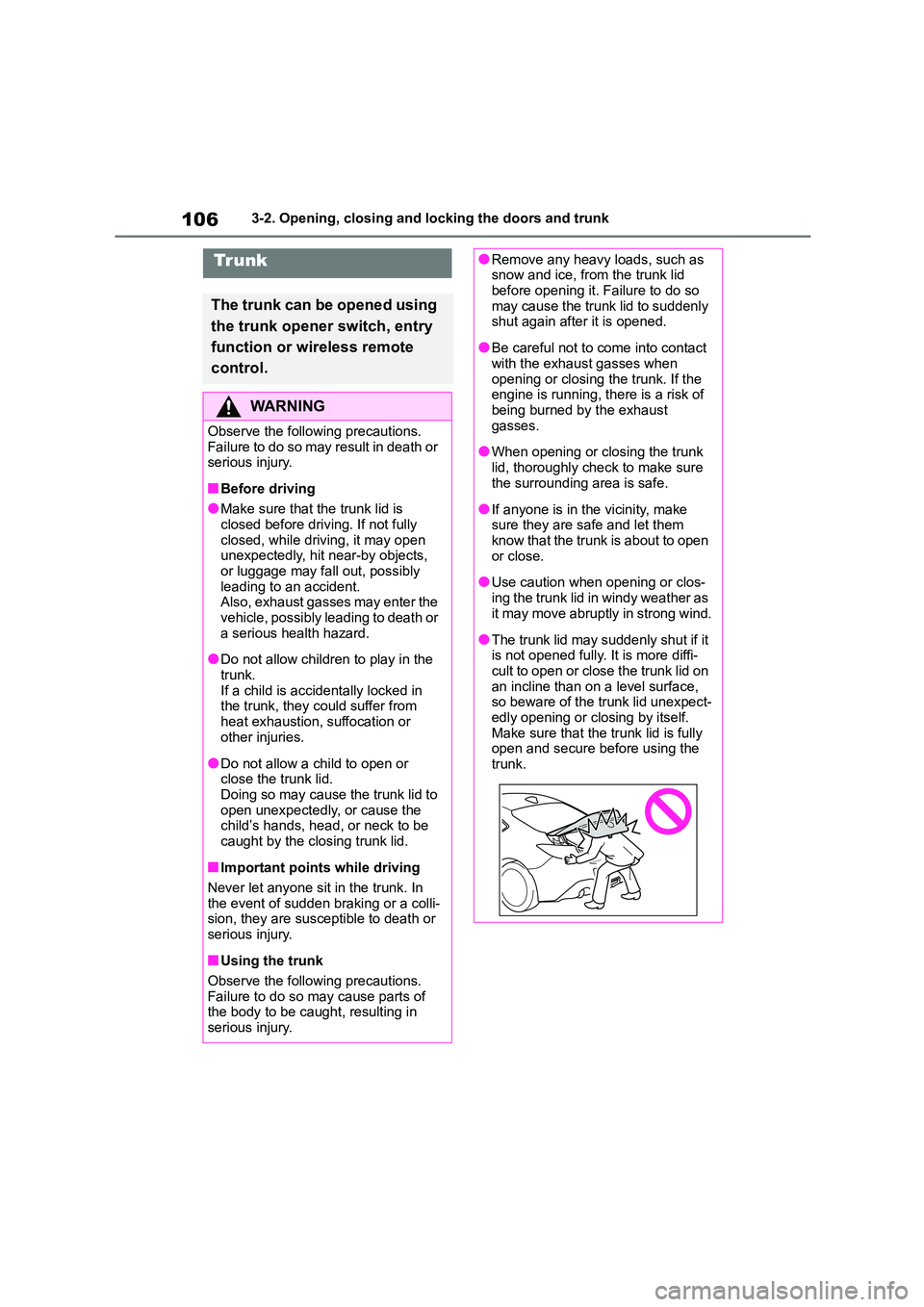
1063-2. Opening, closing and locking the doors and trunk
Trunk
The trunk can be opened using
the trunk opener switch, entry
function or wireless remote
control.
WA R N I N G
Observe the following precautions.
Failure to do so may result in death or
serious injury.
■Before driving
●Make sure that the trunk lid is closed before driving. If not fully
closed, while driving, it may open
unexpectedly, hit near-by objects, or luggage may fall out, possibly
leading to an accident.
Also, exhaust gasses may enter the vehicle, possibly leading to death or
a serious health hazard.
●Do not allow children to play in the
trunk.
If a child is accidentally locked in the trunk, they could suffer from
heat exhaustion, suffocation or
other injuries.
●Do not allow a child to open or
close the trunk lid. Doing so may cause the trunk lid to
open unexpectedly, or cause the
child’s hands, head, or neck to be caught by the closing trunk lid.
■Important points while driving
Never let anyone sit in the trunk. In
the event of sudden braking or a colli-
sion, they are susceptible to death or serious injury.
■Using the trunk
Observe the following precautions.
Failure to do so may cause parts of
the body to be caught, resulting in serious injury.
●Remove any heavy loads, such as snow and ice, from the trunk lid
before opening it. Failure to do so
may cause the trunk lid to suddenly shut again after it is opened.
●Be careful not to come into contact with the exhaust gasses when
opening or closing the trunk. If the
engine is running, there is a risk of being burned by the exhaust
gasses.
●When opening or closing the trunk
lid, thoroughly check to make sure
the surrounding area is safe.
●If anyone is in the vicinity, make
sure they are safe and let them know that the trunk is about to open
or close.
●Use caution when opening or clos-
ing the trunk lid in windy weather as
it may move abruptly in strong wind.
●The trunk lid may suddenly shut if it
is not opened fully. It is more diffi- cult to open or close the trunk lid on
an incline than on a level surface,
so beware of the trunk lid unexpect- edly opening or closing by itself.
Make sure that the trunk lid is fully
open and secure before using the trunk.
Page 114 of 582
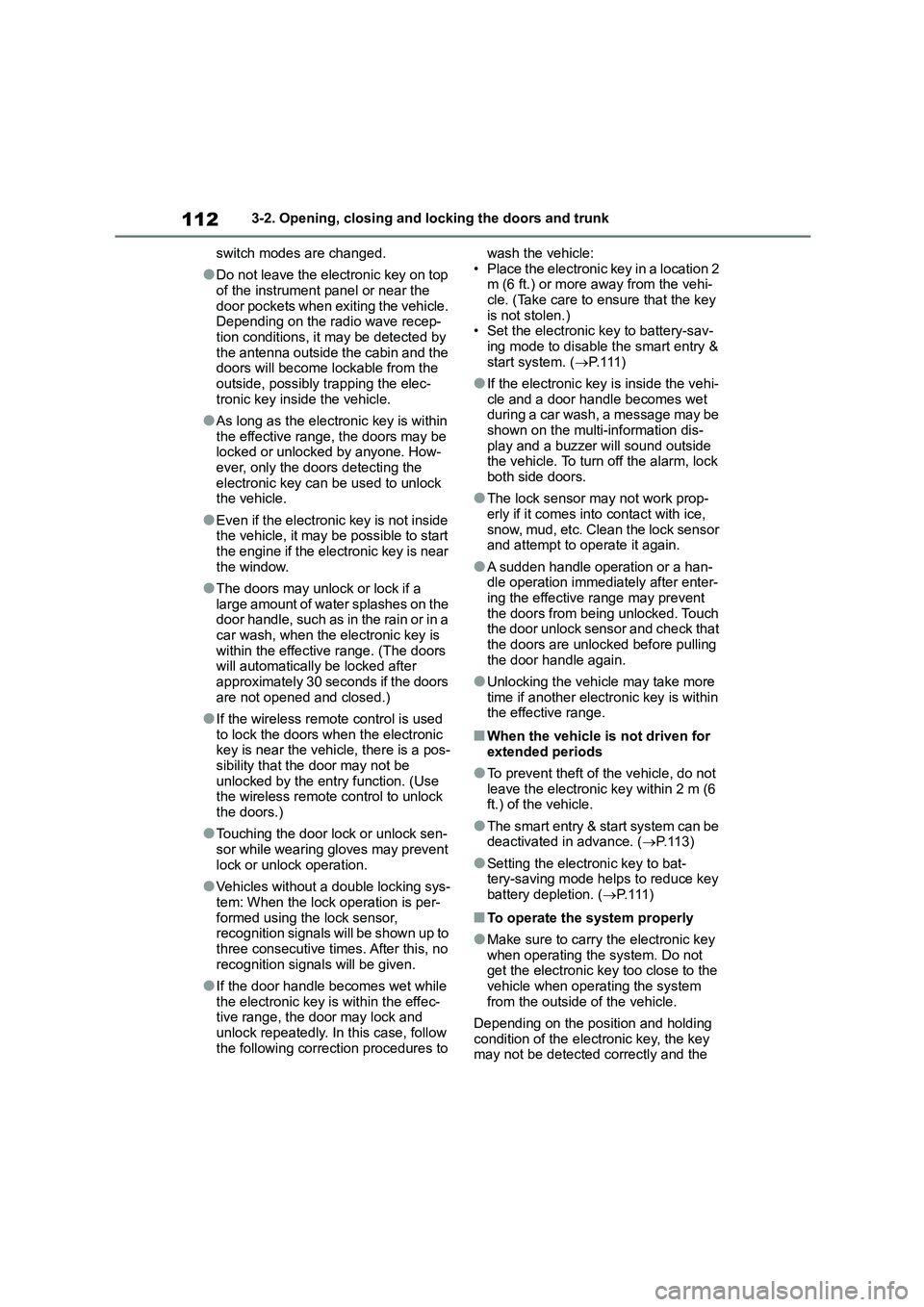
1123-2. Opening, closing and locking the doors and trunk
switch modes are changed.
●Do not leave the electronic key on top
of the instrument panel or near the
door pockets when exiting the vehicle. Depending on the radio wave recep-
tion conditions, it may be detected by
the antenna outside the cabin and the doors will become lockable from the
outside, possibly trapping the elec-
tronic key inside the vehicle.
●As long as the electronic key is within
the effective range, the doors may be locked or unlocked by anyone. How-
ever, only the doors detecting the
electronic key can be used to unlock the vehicle.
●Even if the electronic key is not inside the vehicle, it may be possible to start
the engine if the electronic key is near
the window.
●The doors may unlock or lock if a
large amount of water splashes on the door handle, such as in the rain or in a
car wash, when the electronic key is
within the effective range. (The doors will automatically be locked after
approximately 30 seconds if the doors
are not opened and closed.)
●If the wireless remote control is used
to lock the doors when the electronic key is near the vehicle, there is a pos-
sibility that the door may not be
unlocked by the entry function. (Use the wireless remote control to unlock
the doors.)
●Touching the door lock or unlock sen-
sor while wearing gloves may prevent
lock or unlock operation.
●Vehicles without a double locking sys-
tem: When the lock operation is per-
formed using the lock sensor, recognition signals will be shown up to
three consecutive times. After this, no
recognition signals will be given.
●If the door handle becomes wet while
the electronic key is within the effec- tive range, the door may lock and
unlock repeatedly. In this case, follow
the following correction procedures to
wash the vehicle:
• Place the electronic key in a location 2 m (6 ft.) or more away from the vehi-
cle. (Take care to ensure that the key
is not stolen.) • Set the electronic key to battery-sav-
ing mode to disable the smart entry &
start system. ( P. 1 1 1 )
●If the electronic key is inside the vehi-
cle and a door handle becomes wet during a car wash, a message may be
shown on the multi-information dis-
play and a buzzer will sound outside the vehicle. To turn off the alarm, lock
both side doors.
●The lock sensor may not work prop-
erly if it comes into contact with ice,
snow, mud, etc. Clean the lock sensor and attempt to operate it again.
●A sudden handle operation or a han-dle operation immediately after enter-
ing the effective range may prevent
the doors from being unlocked. Touch the door unlock sensor and check that
the doors are unlocked before pulling
the door handle again.
●Unlocking the vehicle may take more
time if another electronic key is within the effective range.
■When the vehicle is not driven for
extended periods
●To prevent theft of the vehicle, do not
leave the electronic key within 2 m (6
ft.) of the vehicle.
●The smart entry & start system can be
deactivated in advance. ( P. 1 1 3 )
●Setting the electronic key to bat-
tery-saving mode helps to reduce key battery depletion. ( P. 1 1 1 )
■To operate the system properly
●Make sure to carry the electronic key
when operating th e system. Do not get the electronic key too close to the
vehicle when operating the system
from the outside of the vehicle.
Depending on the position and holding
condition of the electronic key, the key may not be detected correctly and the
Page 128 of 582
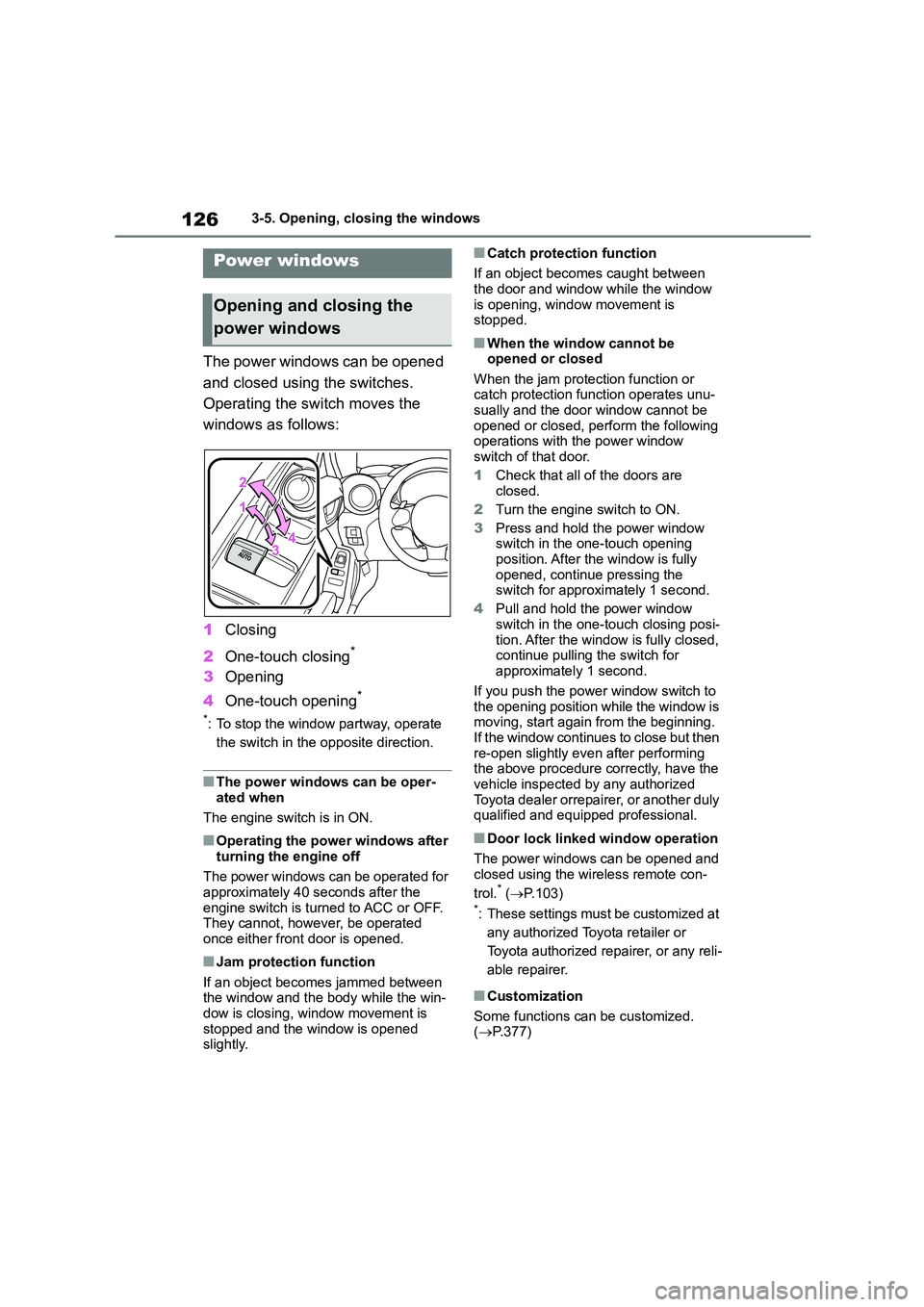
1263-5. Opening, closing the windows
3-5.Opening, closing the windows
The power windows can be opened
and closed using the switches.
Operating the switch moves the
windows as follows:
1 Closing
2 One-touch closing*
3Opening
4 One-touch opening*
*: To stop the window partway, operate
the switch in the opposite direction.
■The power windows can be oper-
ated when
The engine switch is in ON.
■Operating the power windows after
turning the engine off
The power windows can be operated for approximately 40 seconds after the
engine switch is turned to ACC or OFF.
They cannot, however, be operated once either front door is opened.
■Jam protection function
If an object becomes jammed between
the window and the body while the win- dow is closing, window movement is
stopped and the window is opened
slightly.
■Catch protection function
If an object becomes caught between the door and window while the window
is opening, window movement is
stopped.
■When the window cannot be opened or closed
When the jam protection function or
catch protection function operates unu- sually and the door window cannot be
opened or closed, perform the following
operations with the power window switch of that door.
1 Check that all of the doors are
closed.
2 Turn the engine switch to ON.
3 Press and hold the power window
switch in the one-touch opening position. After the window is fully
opened, continue pressing the
switch for approximately 1 second.
4 Pull and hold the power window switch in the one-touch closing posi-
tion. After the window is fully closed,
continue pulling the switch for approximately 1 second.
If you push the power window switch to
the opening position while the window is moving, start again from the beginning.
If the window continues to close but then
re-open slightly even after performing the above procedure correctly, have the
vehicle inspected by any authorized
Toyota dealer orrepairer, or another duly qualified and equipped professional.
■Door lock linked window operation
The power windows can be opened and
closed using the wireless remote con-
trol.* ( P.103)*: These settings must be customized at
any authorized Toyota retailer or
Toyota authorized repairer, or any reli-
able repairer.
■Customization
Some functions can be customized.
( P.377)
Power windows
Opening and closing the
power windows
Page 129 of 582
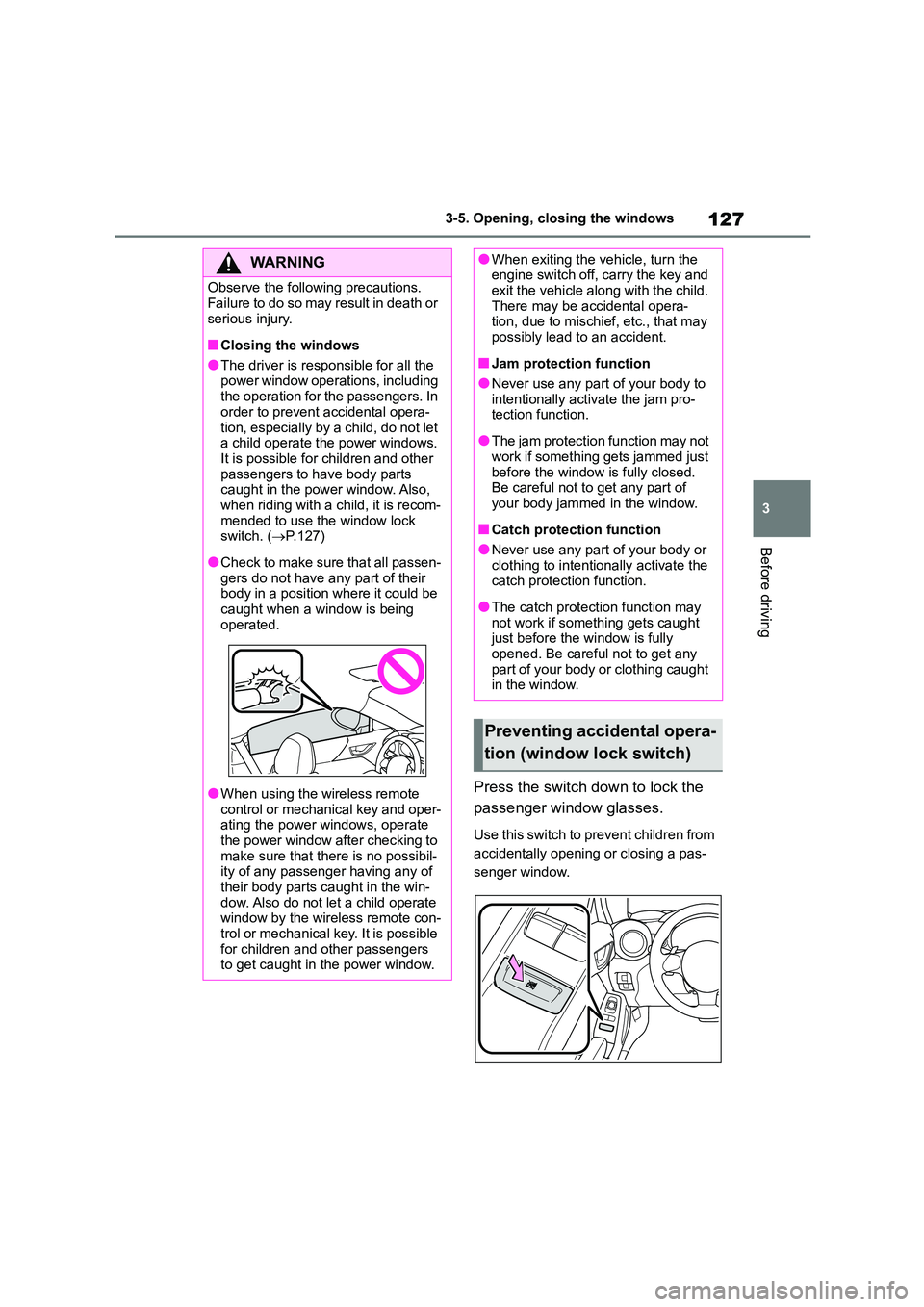
127
3
3-5. Opening, closing the windows
Before driving
Press the switch down to lock the
passenger window glasses.
Use this switch to prevent children from
accidentally opening or closing a pas-
senger window.
WA R N I N G
Observe the following precautions.
Failure to do so may result in death or
serious injury.
■Closing the windows
●The driver is responsible for all the power window operations, including
the operation for the passengers. In
order to prevent accidental opera-
tion, especially by a child, do not let a child operate the power windows.
It is possible for children and other
passengers to have body parts caught in the power window. Also,
when riding with a child, it is recom-
mended to use the window lock switch. ( P.127)
●Check to make sure that all passen- gers do not have any part of their
body in a position where it could be
caught when a window is being operated.
●When using the wireless remote control or mechanical key and oper-
ating the power windows, operate
the power window after checking to make sure that there is no possibil-
ity of any passenger having any of
their body parts caught in the win- dow. Also do not let a child operate
window by the wireless remote con-
trol or mechanical key. It is possible for children and other passengers
to get caught in the power window.
●When exiting the vehicle, turn the engine switch off, carry the key and
exit the vehicle along with the child.
There may be accidental opera- tion, due to mischief, etc., that may
possibly lead to an accident.
■Jam protection function
●Never use any part of your body to
intentionally activate the jam pro- tection function.
●The jam protection function may not work if something gets jammed just
before the window is fully closed.
Be careful not to get any part of your body jammed in the window.
■Catch protection function
●Never use any part of your body or
clothing to intentionally activate the
catch protection function.
●The catch protection function may
not work if something gets caught just before the window is fully
opened. Be careful not to get any
part of your body or clothing caught in the window.
Preventing accidental opera-
tion (window lock switch)
Page 132 of 582

1304-1. Before driving
4-1.Before driving
■Starting the engine
P. 1 3 9
■Driving
Automatic transmission
1 With the brake pedal depressed,
shift the shift lever to D.
( P.143)
2 Release the parking brake.
( P.151)
3 Gradually release the brake
pedal and gently depress the
accelerator pedal to accelerate
the vehicle.
Manual transmission
1 While depressing the clutch
pedal, shift the shift lever to 1.
( P.147)
2 Release the parking brake.
( P.151)
3 Gradually release the clutch
pedal. At the same time, gently
depress the accelerator pedal to
accelerate the vehicle.
■Stopping
Automatic transmission
1 With the shift lever in D, depress
the brake pedal.
2 If necessary, set the parking
brake.
If the vehicle is to be stopped for an
extended period of time, shift the shift lever to P. ( P.143)
Manual transmission
1 While depressing the clutch
pedal, depress the brake pedal.
2 If necessary, set the parking
brake.
If the vehicle is to be stopped for an extended period of time, shift the shift
lever to N. ( P.147)
■Parking the vehicle
Automatic transmission
1 With the shift lever in D, depress
the brake pedal to stop the vehi-
cle completely.
2 Set the parking brake (P.151),
shift the shift lever to P.
( P.143)
Check the parking brake indicator is
illuminated.
3 Press the engine switch to stop
the engine.
4 Slowly release the brake pedal.
5 Lock the door, making sure that
you have the key on your per-
son.
If parking on a hill, block the wheels as
needed.
Manual transmission
1 While depressing the clutch
pedal, depress the brake pedal
to stop the vehicle completely.
2 Set the parking brake. (P.151)
Check that the parking brake indicator
Driving the vehicle
The following procedures
should be observed to ensure
safe driving:
Driving procedure
Page 135 of 582

133
4
4-1. Before driving
Driving
WA R N I N G
●During normal driving, do not turn
off the engine. Turning the engine
off while driving will not cause loss of steering or braking control, but
the power assist to these systems
will be lost. This will make it more difficult to steer and brake, so you
should pull over and stop the vehi-
cle as soon as it is safe to do so.
However, in the event of an emer- gency, such as if it becomes impos-
sible to stop the vehicle in the
normal way: P. 3 2 6
●Use engine braking (downshift) to
maintain a safe speed when driving down a steep hill.
Using the brakes continuously may
cause the brakes to overheat and lose effectiveness. (P.143, 147)
●Do not adjust the positions of the steering wheel, the seat, or the
inside or outside rear view mirrors
while driving. Doing so may result in a loss of
vehicle control.
●Always check that all passengers’
arms, heads or other parts of their
body are not outside the vehicle.
■When driving on slippery road
surfaces
●Sudden braking, acceleration and
steering may cause tire slippage
and reduce your ability to control the vehicle.
●Sudden acceleration, engine brak-ing due to shifting, or changes in
engine speed could cause the vehi-
cle to skid.
●After driving through a puddle, lightly depress the brake pedal to
make sure that the brakes are func-
tioning properly. Wet brake pads may prevent the brakes from func-
tioning properly. If the brakes on
only one side are wet and not func- tioning properly, steering control
may be affected.
■When shifting the shift lever
●Vehicles with an automatic trans-
mission: Do not let the vehicle roll backward while the sh ift lever is in a
driving position, or roll forward while
the shift lever is in R. Doing so may cause the engine to
stall or lead to poor brake and
steering performance, resulting in an accident or damage to the vehi-
cle.
●Vehicles with an automatic trans-
mission: Do not shi ft the shift lever
to P while the vehicle is moving. Doing so can damage the transmis-
sion and may result in a loss of
vehicle control.
●Do not shift the shift lever to a driv-
ing position while the vehicle is moving backward.
Doing so can damage the transmis-
sion and may result in a loss of vehicle control.
●Do not shift the shift lever to R while the vehicle is moving forward.
Doing so can damage the transmis-
sion and may result in a loss of vehicle control.
●Moving the shift lever to N while the vehicle is moving will disengage the
engine from the transmission.
Engine braking is not available
when N is selected.
Page 136 of 582

1344-1. Before driving
WA R N I N G
●Vehicles with an automatic trans-
mission: Be careful not to shift the
shift lever with the accelerator pedal depressed. Shifting the shift
lever to a gear other than P or N
may lead to unexpected rapid acceleration of the vehicle that may
cause an accident and result in
death or serious injury.
●Do not place items in the shift
lever's surrounding area. It may
cause incorrect operation.
●If the shift boot is pulled out during
cleaning, return it to its previous position. If the shift boot is left
pulled out, the shift lever may
become difficult to operate.
■If you hear a squealing or scrap-
ing noise (brake pad wear indica- tors)
Have the brake pads checked and
replaced by any authorized Toyota retailer or Toyota authorized repairer,
or any reliable repairer as soon as
possible. Rotor damage may result if the pads are not replaced when
needed.
It is dangerous to drive the vehicle when the wear limits of the brake
pads and/or those of the brake discs
are exceeded.
■When the vehicle is stopped
●Do not race the engine. If the vehicle is in any gear other
than P (automatic transmission) or
N, the vehicle may accelerate sud- denly and unexpectedly, causing an
accident.
●Vehicles with an automatic trans-
mission: In order to prevent acci-
dents due to the vehicle rolling away, always keep depressing the
brake pedal while the engine is run-
ning, and apply the parking brake as necessary.
●If the vehicle is stopped on an incline, in order to prevent acci-
dents caused by the vehicle rolling
forward or backward, always depress the brake pedal and
securely apply the parking brake as
needed.
●Avoid revving or racing the engine.
Running the engine at high speed while the vehicle is stopped may
cause the exhaust system to over-
heat, which could result in a fire if combustible material is nearby.
■When the vehicle is parked
●Do not leave glasses, cigarette
lighters, spray cans, or soft drink
cans in the vehicle when it is in the sun.
Doing so may result in the follow-
ing:
• Gas may leak from a cigarette
lighter or spray can, and may lead
to a fire.
• The temperature inside the vehicle
may cause the plastic lenses and plastic material of glasses to
deform or crack.
• Soft drink cans may fracture, caus-
ing the contents to spray over the
interior of the vehicle, and may also cause a short circuit in the vehicle’s
electrical components.
●Do not leave cigarette lighters in the
vehicle. If a cigarette lighter is in a
place such as the glove box or on the floor, it may be lit accidentally
when luggage is loaded or the seat
is adjusted, causing a fire.
●Do not attach adh esive discs to the
windshield or windows. Do not
place containers such as air fresh- eners on the instrument panel or
dashboard. Adhesive discs or con-
tainers may act as lenses, causing a fire in the vehicle.
Page 137 of 582

135
4
4-1. Before driving
Driving
WA R N I N G
●Do not leave a door or window
open if the curved glass is coated
with a metallized film such as a sil- ver-colored one. Reflected sunlight
may cause the glass to act as a
lens, causing a fire.
●Always apply the parking brake,
shift the shift lever to P (vehicles
with an automatic transmission), stop the engine and lock the vehi-
cle.
Do not leave the vehicle unat- tended while the engine is running.
If the vehicle is parked with the shift
lever in P but the parking brake is not set, the vehicl e may start to
move, possibly leading to an acci-
dent.
●Do not touch the exhaust pipes
while the engine is running or immediately after turning the engine
off.
Doing so may cause burns.
■When taking a nap in the vehicle
Always turn the engine off. Otherwise, if you accidentally move the shift lever
or depress the accelerator pedal, this
could cause an accident or fire due to engine overheating. Additionally, if the
vehicle is parked in a poorly ventilated
area, exhaust gases may collect and enter the vehicle, leading to death or
a serious health hazard.
■When braking
●When the brakes are wet, drive
more cautiously. Braking distance increases when
the brakes are wet, and this may
cause one side of the vehicle to brake differently than the other
side. Also, the parking brake may
not securely hold the vehicle.
●If the brake booster device does not operate, do not follow other vehi-
cles closely and avoid hills or sharp
turns that require braking. In this case, braking is still possible,
but the brake pedal should be
depressed more firmly than usual. Also, the braking distance will
increase. Have your brakes fixed
immediately.
●Do not pump the brake pedal if the
engine stalls. Each push on the brake pedal uses
up the reserve for the
power-assisted brakes.
●The brake system consists of 2 indi-
vidual hydraulic systems; if one of the systems fails, the other will still
operate. In this case, the brake
pedal should be depressed more firmly than usual and the braking
distance will increase. Have your
brakes fixed immediately.
■If the vehicle becomes stuck
Do not spin the wheels excessively when any of the tires is up in the air,
or the vehicle is stuck in sand, mud,
etc. This may damage the driveline components or propel the vehicle for-
ward or backward, causing an acci-
dent.
NOTICE
■Pre-driving check
Trapping small animals in the cooling
fan and belts of the engine may result
in a malfunction. Check that no small animal enters the engine compart-
ment and under the vehicle before
starting the engine.
Page 139 of 582
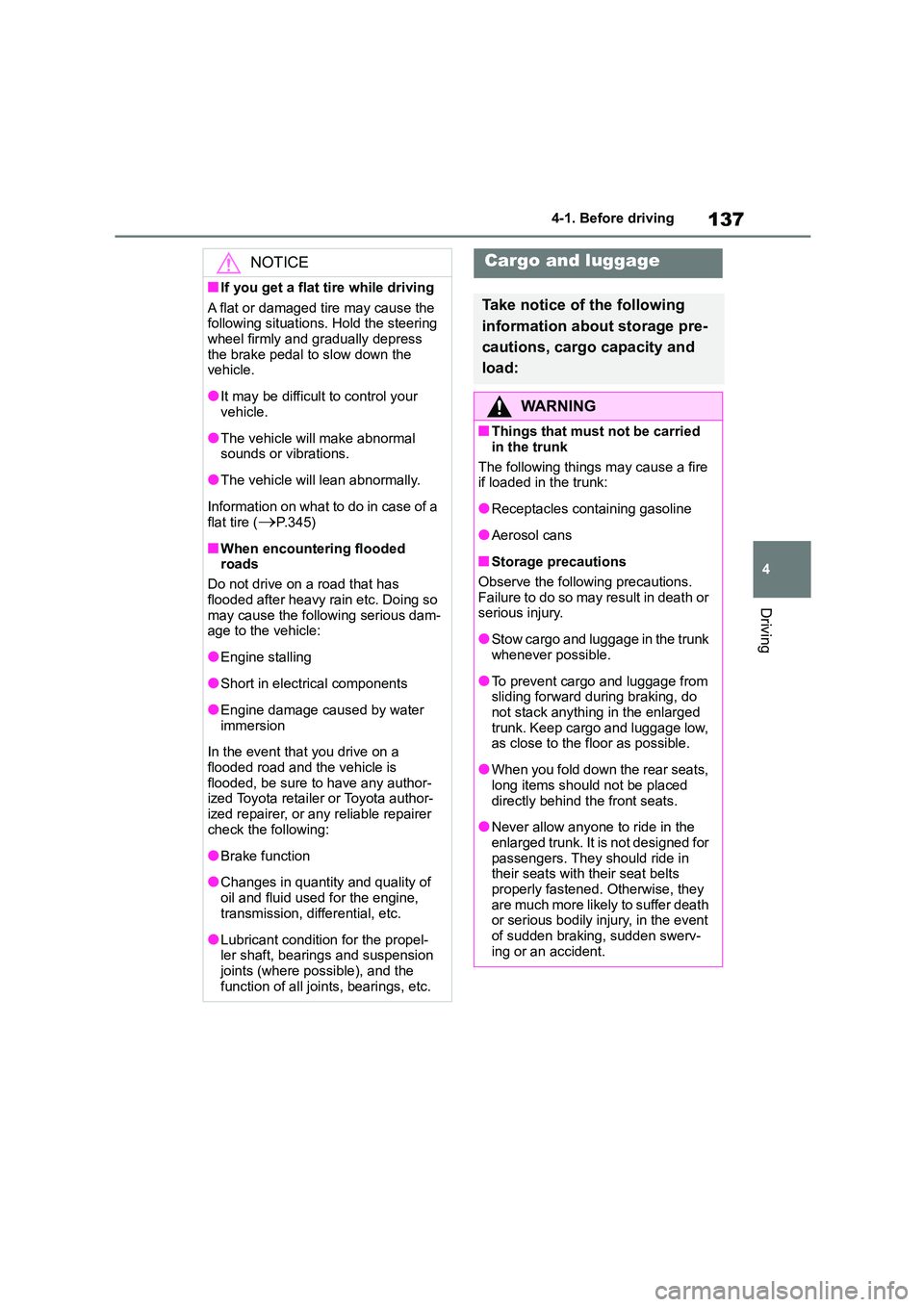
137
4
4-1. Before driving
Driving
NOTICE
■If you get a flat tire while driving
A flat or damaged tire may cause the
following situations. Hold the steering wheel firmly and gradually depress
the brake pedal to slow down the
vehicle.
●It may be difficult to control your
vehicle.
●The vehicle will make abnormal
sounds or vibrations.
●The vehicle will lean abnormally.
Information on what to do in case of a flat tire (P.345)
■When encountering flooded roads
Do not drive on a road that has
flooded after heavy rain etc. Doing so may cause the following serious dam-
age to the vehicle:
●Engine stalling
●Short in electrical components
●Engine damage caused by water
immersion
In the event that you drive on a
flooded road and the vehicle is flooded, be sure to have any author-
ized Toyota retailer or Toyota author-
ized repairer, or any reliable repairer check the following:
●Brake function
●Changes in quantity and quality of
oil and fluid used for the engine, transmission, differential, etc.
●Lubricant condition for the propel-ler shaft, bearings and suspension
joints (where possible), and the
function of all joints, bearings, etc.
Cargo and luggage
Take notice of the following
information about storage pre-
cautions, cargo capacity and
load:
WA R N I N G
■Things that must not be carried
in the trunk
The following things may cause a fire if loaded in the trunk:
●Receptacles containing gasoline
●Aerosol cans
■Storage precautions
Observe the following precautions.
Failure to do so may result in death or serious injury.
●Stow cargo and luggage in the trunk whenever possible.
●To prevent cargo and luggage from sliding forward during braking, do
not stack anything in the enlarged
trunk. Keep cargo and luggage low, as close to the floor as possible.
●When you fold down the rear seats, long items should not be placed
directly behind the front seats.
●Never allow anyone to ride in the
enlarged trunk. It is not designed for
passengers. They should ride in their seats with their seat belts
properly fastened. Otherwise, they
are much more likely to suffer death or serious bodily injury, in the event
of sudden braking, sudden swerv-
ing or an accident.
Page 141 of 582
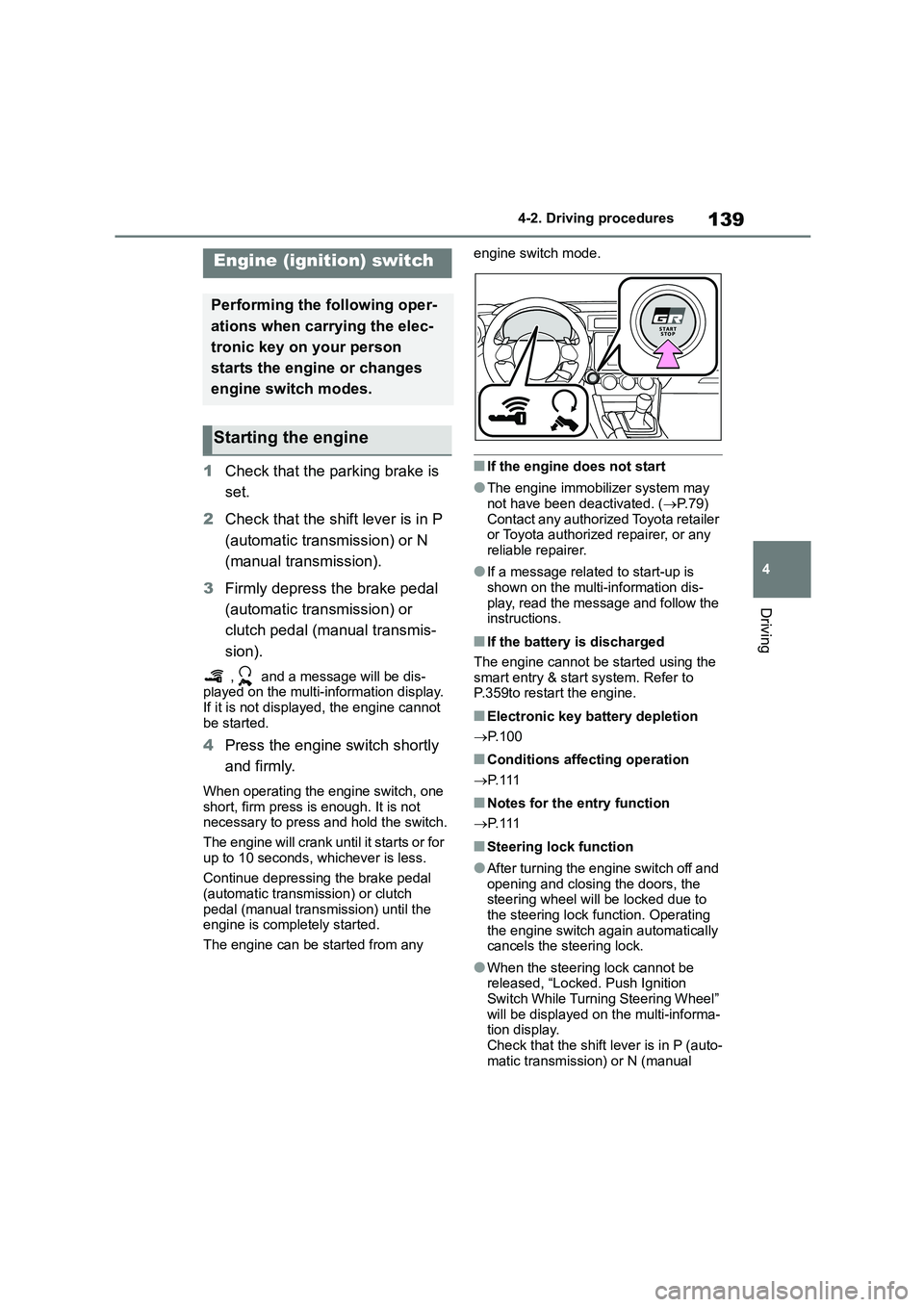
139
4
4-2. Driving procedures
Driving
4-2.Driving procedures
1 Check that the parking brake is
set.
2 Check that the shift lever is in P
(automatic transmission) or N
(manual transmission).
3 Firmly depress the brake pedal
(automatic transmission) or
clutch pedal (manual transmis-
sion).
, and a message will be dis- played on the multi-information display.
If it is not displayed, the engine cannot
be started.
4 Press the engine switch shortly
and firmly.
When operating the engine switch, one
short, firm press is enough. It is not necessary to press and hold the switch.
The engine will crank until it starts or for
up to 10 seconds, whichever is less.
Continue depressing the brake pedal
(automatic transmission) or clutch
pedal (manual transmission) until the engine is completely started.
The engine can be started from any
engine switch mode.
■If the engine does not start
●The engine immobilizer system may
not have been deactivated. ( P. 7 9 )
Contact any authorized Toyota retailer or Toyota authorized repairer, or any
reliable repairer.
●If a message related to start-up is
shown on the multi-information dis-
play, read the message and follow the instructions.
■If the battery is discharged
The engine cannot be started using the
smart entry & start system. Refer to P.359to restart the engine.
■Electronic key battery depletion
P. 1 0 0
■Conditions affecting operation
P. 1 1 1
■Notes for the entry function
P. 1 1 1
■Steering lock function
●After turning the engine switch off and opening and closing the doors, the
steering wheel will be locked due to
the steering lock function. Operating
the engine switch again automatically cancels the steering lock.
●When the steering lock cannot be released, “Locked. Push Ignition
Switch While Turning Steering Wheel”
will be displayed on the multi-informa- tion display.
Check that the shift lever is in P (auto-
matic transmission) or N (manual
Engine (ignition) switch
Performing the following oper-
ations when carrying the elec-
tronic key on your person
starts the engine or changes
engine switch modes.
Starting the engine